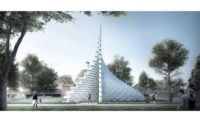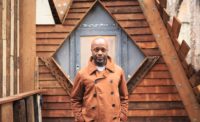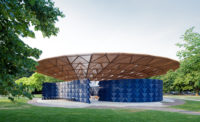London
“Bigamy” in architecture, at least according to the Copenhagen-based Bjarke Ingels Group, means the combination of diametrically opposed parts. “Quite often, interesting things happen when you take seemingly incompatible elements and you combine them into a new hybrid,” Ingels said last month at the unveiling of his firm’s design for the Serpentine Pavilion, a temporary structure commissioned each summer by London’s Serpentine Gallery to grace the front lawn of Kensington Gardens.
For the 2016 pavilion, BIG’s design uses modular elements to create organic shapes: 1,802 elongated composite fiberglass frames are stacked to form two enclosing walls that are pushed outward or “unzipped,” as the Danish architect likes to say, to create a contoured, cavernous interior filled with simple geometric seating and a sculptural exterior.
Viewed head-on from the east or west, the hollow blocks form a matrix of right angles, but as visitors circulate, the calculated protrusions bring the walls to a swell. As do pixels, the surface of each rectangular frame captures the nuances< of light and shadow, so the entirety seems like a host of formal contradictions and endless metaphors: “a wall becomes a hole,” Ingels says, “a structure that is free-form yet rigorous; modular yet sculptural; both transparent and opaque; both solid box and blob.”
As every year, the Serpentine Pavilion houses a café and serves as the centerpiece of the gallery’s outdoor summer programming. This year it is joined by a four additional follies. As a final farewell to departing Serpentine Gallery director Julia Peyton-Jones, who launched the pavilion program in 2000, the gallery commissioned accompanying works by Yona Friedman, Asif Khan, Barkow Leibinger, and Kunlé Adeyemi. Each firm created a radically different “summerhouse” in response to Queen Caroline’s Temple, a neoclassical folly attributed to William Kent that has adorned Kensington Gardens since 1734. Barkow Leibinger built a wood structure featuring a canopy of curling structural bands, and Khan erected a polished metal platform fenced in by white timber staves. Friedman’s modular grid of wire hoops, meanwhile, refers to his 1959 urban-planning manifesto, La Ville Spatiale. For his part, Adeyemi created an “inverse replica” of the temple, using the proportions and forms of the neoclassical original while emphasizing its voids. The masses rely on prefabricated sandstone block similar to the stone used in the temple, and the architect upholstered its interior with a cushy white vinyl. “We wanted to pay homage to that 18th-century structure,” Adeyemi says, about his “place for shade and relaxation.”






















Post a comment to this article
Report Abusive Comment